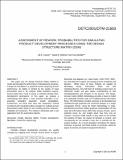| dc.contributor.author | Yassine, Ali A. | |
| dc.contributor.author | Whitney, Daniel E. | |
| dc.contributor.author | Zambito, Tony | |
| dc.date.accessioned | 2002-09-17T16:48:40Z | |
| dc.date.available | 2002-09-17T16:48:40Z | |
| dc.date.issued | 2001-09-09 | |
| dc.identifier.uri | http://hdl.handle.net/1721.1/1673 | |
| dc.description.abstract | This paper uses the Design Structure Matrix (DSM) to
model and simulate the performance of development processes.
Though the simulation is a powerful tool for analyzing process
performance, its ability is limited by the quality of input
information used in the analysis. DSM simulation requires
process data that is hard to assess or estimate directly from
development participants. In this paper, we propose a
methodology that allows a more practical estimation of an
important simulation parameter: rework probabilities.
Furthermore, we show how does this assessment method
(combined with simulation) allow managers to evaluate process
improvement plans based on two resulting process measures:
reliability and robustness. The method is illustrated with a real
application from the automotive industry. | en |
| dc.format.extent | 400229 bytes | |
| dc.format.mimetype | application/pdf | |
| dc.language.iso | en_US | |
| dc.relation.ispartofseries | ASME International Design Engineering Technical Conferences; | |
| dc.subject | process re-engineering | en |
| dc.subject | product development | en |
| dc.subject | simulation | en |
| dc.subject | design structure matrix | en |
| dc.title | Assessment of Rework Probabilities for Simulating Product Development Processes Using the Design Structure Matrix (DSM) | en |
